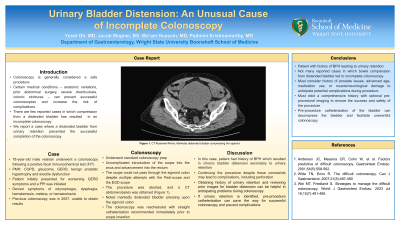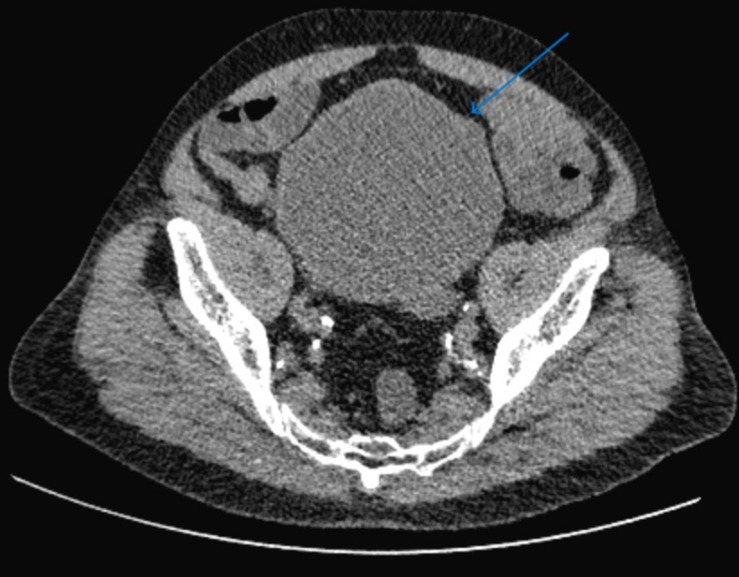Sunday Poster Session
Category: General Endoscopy
P0710 - Urinary Bladder Distension: An Unusual Cause of Incomplete Colonoscopy
Sunday, October 27, 2024
3:30 PM - 7:00 PM ET
Location: Exhibit Hall E

Has Audio
- YO
Yesol Oh, MD
Wright State University
Dayton, OH
Presenting Author(s)
Yesol Oh, MD1, Jacob Wagner, BS1, Omair Khan, MS2, We'am Hussain, MD3, Padmini Krishnamurthy, MD1
1Wright State University, Dayton, OH; 2Kansas City University, Dayton, OH; 3Wright State University Boonshoft School of Medicine, Dayton, OH
Introduction: While colonoscopy is generally considered a safe procedure, certain medical conditions can prevent its successful completion. Reasons for incomplete colonoscopy include looping within an inguinal hernia, tortuous and angulated colon, severe diverticulosis, adhesions, and patient discomfort.1 Here, we report a case where a distended bladder from urinary retention led to the inability of the scope to pass through the sigmoid colon, resulting in unsuccessful completion of the procedure.
Case Description/Methods: A 78-year-old male veteran was referred for colonoscopy by his outpatient gastroenterologist after a positive fecal immunochemical test (FIT). His past medical history was significant for glaucoma, benign prostatic hypertrophy (BPH), and erectile dysfunction. Initially presenting with worsening symptoms of gastric reflux, the patient underwent FIT after lab results indicated microcytic anemia. He was unable to recall the results of his prior colonoscopy from 16 years ago. The FIT returned positive, and a colonoscopy was scheduled. The patient underwent standard colonoscopy prep prior to the procedure. The procedure initially proceeded smoothly as the scope was introduced into the anus and advanced under direct visualization to the sigmoid colon. However, the scope was unable to pass through the sigmoid colon due to tight bending, despite multiple attempts with the Pedi-scope and the EGD scope. The colonoscopy was aborted, and a CT abdomen/pelvis was obtained to investigate the cause of the obstruction. CT imaging revealed a markedly distended bladder which was pressing upon the adjacent bowel loops, including the sigmoid colon (Figure 1). The colonoscopy was rescheduled for a later date with straight catheterization recommended immediately prior to scope insertion.
Discussion: In this case, the patient had a history of BPH leading to chronic bladder distension and urinary retention. There have not been many reported cases in which bowel compression from a distended bladder resulted in incomplete colonoscopy. However, given the high prevalence of BPH among the elderly population, obtaining history of urinary retention and reviewing prior imaging can help anticipate potential complications during the procedure. If urinary retention is identified beforehand, pre-procedure catheterization of the bladder can decompress the bladder and facilitate an uneventful colonoscopy.
References:
1. Witte TN, Enns R. The difficult colonoscopy. Can J Gastroenterol. 2007;21(8):487-490

Disclosures:
Yesol Oh, MD1, Jacob Wagner, BS1, Omair Khan, MS2, We'am Hussain, MD3, Padmini Krishnamurthy, MD1. P0710 - Urinary Bladder Distension: An Unusual Cause of Incomplete Colonoscopy, ACG 2024 Annual Scientific Meeting Abstracts. Philadelphia, PA: American College of Gastroenterology.
1Wright State University, Dayton, OH; 2Kansas City University, Dayton, OH; 3Wright State University Boonshoft School of Medicine, Dayton, OH
Introduction: While colonoscopy is generally considered a safe procedure, certain medical conditions can prevent its successful completion. Reasons for incomplete colonoscopy include looping within an inguinal hernia, tortuous and angulated colon, severe diverticulosis, adhesions, and patient discomfort.1 Here, we report a case where a distended bladder from urinary retention led to the inability of the scope to pass through the sigmoid colon, resulting in unsuccessful completion of the procedure.
Case Description/Methods: A 78-year-old male veteran was referred for colonoscopy by his outpatient gastroenterologist after a positive fecal immunochemical test (FIT). His past medical history was significant for glaucoma, benign prostatic hypertrophy (BPH), and erectile dysfunction. Initially presenting with worsening symptoms of gastric reflux, the patient underwent FIT after lab results indicated microcytic anemia. He was unable to recall the results of his prior colonoscopy from 16 years ago. The FIT returned positive, and a colonoscopy was scheduled. The patient underwent standard colonoscopy prep prior to the procedure. The procedure initially proceeded smoothly as the scope was introduced into the anus and advanced under direct visualization to the sigmoid colon. However, the scope was unable to pass through the sigmoid colon due to tight bending, despite multiple attempts with the Pedi-scope and the EGD scope. The colonoscopy was aborted, and a CT abdomen/pelvis was obtained to investigate the cause of the obstruction. CT imaging revealed a markedly distended bladder which was pressing upon the adjacent bowel loops, including the sigmoid colon (Figure 1). The colonoscopy was rescheduled for a later date with straight catheterization recommended immediately prior to scope insertion.
Discussion: In this case, the patient had a history of BPH leading to chronic bladder distension and urinary retention. There have not been many reported cases in which bowel compression from a distended bladder resulted in incomplete colonoscopy. However, given the high prevalence of BPH among the elderly population, obtaining history of urinary retention and reviewing prior imaging can help anticipate potential complications during the procedure. If urinary retention is identified beforehand, pre-procedure catheterization of the bladder can decompress the bladder and facilitate an uneventful colonoscopy.
References:
1. Witte TN, Enns R. The difficult colonoscopy. Can J Gastroenterol. 2007;21(8):487-490

Figure: Figure 1. Abdominal computed tomography scan shows markedly distended bladder compressing the sigmoid region
Disclosures:
Yesol Oh indicated no relevant financial relationships.
Jacob Wagner indicated no relevant financial relationships.
Omair Khan indicated no relevant financial relationships.
We'am Hussain indicated no relevant financial relationships.
Padmini Krishnamurthy indicated no relevant financial relationships.
Yesol Oh, MD1, Jacob Wagner, BS1, Omair Khan, MS2, We'am Hussain, MD3, Padmini Krishnamurthy, MD1. P0710 - Urinary Bladder Distension: An Unusual Cause of Incomplete Colonoscopy, ACG 2024 Annual Scientific Meeting Abstracts. Philadelphia, PA: American College of Gastroenterology.

